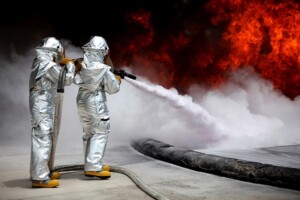In 2021, NSW became the second Australian state to ban the use of firefighting foam that contains perfluoroalkyl substances (PFAS). While the health effects of these substances on human beings are still being studied, they are known to be toxic to fish and some animals.
If you have fire extinguishers on your premises, you should check whether they contain PFAS, and if so, make a plan to replace them.

PFAS: what are they?
PFAS are a class of manufactured chemicals that have been in use since the 1950s to make products designed to resist heat, stains, grease or water.
In 2017, the ABC’s Four Corners programme revealed that PFAS-containing firefighting foams had contaminated soil and groundwater at a number of Australian Defence Force facilities.
According to the Australian Department of Health, this kind of contamination is of concern ‘because these chemicals are highly persistent, have been shown to be toxic to fish and some animals, and can accumulate in the bodies of fish, animals and people who come into contact with them’.
NSW regulations ban PFAS in firefighting foam
The NSW Government has taken the initiative to ban the use of PFAS-containing firefighting foam, except in fighting catastrophic fires or where there are special exemptions.
NSW became the second jurisdiction in Australia to introduce a ban on use of fluorinated foams, after South Australia introduced a similar ban in 2018. The NSW Government described the changes as a key step for the state towards achieving the objectives agreed in the National PFAS Position Statement prepared by federal, state and territory governments.
What you can do now
Most businesses have fire extinguishers on site. If you’re in NSW, now is the time when you should be reviewing your fire extinguisher program, and making a plan to replace any PFAS-containing products.
If you manage an industrial facility in NSW with firefighting training grounds, you should review your use of PFAS-containing products now.
Wherever you are in Australia, regulations around PFAS are being regularly reviewed by state and territory governments and EPAs. Make sure you keep up to date so you don’t miss any changes.

How Airsafe can help
Appropriate management, storage and disposal of PFAS can be complex. Airsafe can help your organisation by conducting a risk assessment and advising on the steps you should take, following the framework set out in the PFAS National Environment Management Plan 2.0.



